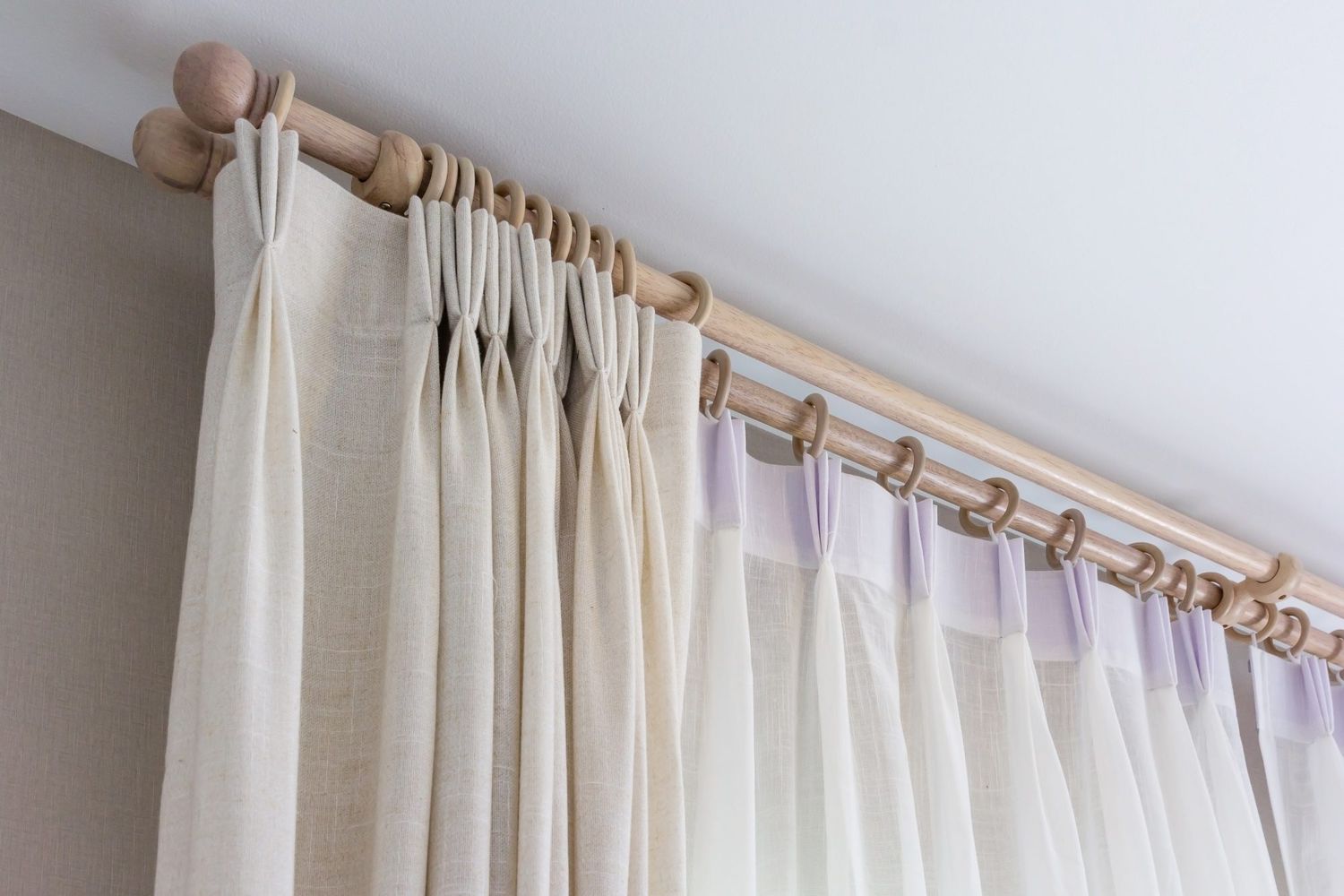Home>Storage Ideas>Bedroom Storage>How To Clean Curtains And Drapes For Spotless Window Treatments


Bedroom Storage
How To Clean Curtains And Drapes For Spotless Window Treatments
Modified: March 1, 2024
Learn how to clean your curtains and drapes to keep your bedroom spotless and organized with our expert tips on bedroom storage.
(Many of the links in this article redirect to a specific reviewed product. Your purchase of these products through affiliate links helps to generate commission for Storables.com, at no extra cost. Learn more)
Introduction
When it comes to maintaining a spotless bedroom, one often-overlooked aspect is the curtains and drapes. These window treatments not only add charm and style to a bedroom, but they can also collect dust, dirt, and allergens over time. Cleaning curtains and drapes regularly is essential not only for a clean and hygienic bedroom environment but also to prolong the life of these window coverings.
In this article, we will explore various methods for cleaning curtains and drapes, ensuring that they remain beautiful and spotless. From checking the care labels to removing stains and maintaining their appearance, we’ll cover it all. So, let’s dive in and discover the secrets to achieving spotless window treatments in your bedroom.
Key Takeaways:
- Keep your bedroom curtains spotless by following care label instructions, pre-treating stains, and choosing the right cleaning method. Regular maintenance and proper hanging can prolong their lifespan and enhance your bedroom’s ambiance.
- Dust, vacuum, and treat stains promptly to maintain spotless curtains. Choose the appropriate cleaning method based on fabric and care label instructions. Iron or steam for a polished look, and rotate curtains for even wear.
Preparing for Cleaning
Before you begin the cleaning process, it’s important to prepare your curtains and drapes properly. Here are a few steps to follow:
- Remove any accessories: Take off any curtain hooks, pins, or other accessories attached to your curtains or drapes.
- Check for loose threads or tears: Inspect the fabric for any loose threads or tears that may worsen during the cleaning process. If you find any, consider repairing them before proceeding.
- Dust or vacuum: Give your curtains and drapes a thorough dusting or vacuuming to remove loose dirt and debris. Use a soft brush attachment or a handheld vacuum with a brush attachment to gently clean the fabric.
- Test for colorfastness: It’s always wise to perform a colorfastness test on a small, inconspicuous area of the fabric. Dampen a clean cloth with water and blot it on a hidden section of the curtain. If the color transfers onto the cloth, it’s best to proceed with caution or consider professional cleaning instead.
By following these preparation steps, you’ll ensure that your curtains and drapes are ready for a thorough and effective cleaning process.
Checking the Care Label
Before proceeding with any cleaning method, it’s crucial to check the care label attached to your curtains or drapes. The care label provides specific instructions from the manufacturer on how to clean and maintain the fabric. Here are a few common care label symbols and what they mean:
- Machine wash: This symbol indicates that the curtains or drapes can be safely machine washed. Make sure to follow the recommended temperature and cycle settings.
- Hand wash: If you see a symbol of a hand, it means that the fabric should be gently hand washed. Use a mild detergent and lukewarm water to clean the curtains or drapes.
- Dry clean: This symbol indicates that the curtains or drapes are not suitable for home laundering and should be professionally dry cleaned. It’s best to follow this recommendation to avoid damaging the fabric.
- Do not wash: If you see a crossed-out water symbol, it means that the curtains or drapes cannot be washed. In such cases, spot cleaning or professional cleaning may be the only options.
Following the care label instructions is important to prevent damage to the fabric or alteration of its appearance. If the care label is missing or unreadable, consult a professional cleaner or consider testing a small, inconspicuous area before proceeding with the cleaning process.
Dusting and Vacuuming
One of the simplest and most effective ways to clean curtains and drapes is by dusting and vacuuming. This method helps remove loose dirt, dust, and allergens from the fabric’s surface and is especially useful for delicate or non-washable curtains. Here’s how you can do it:
- Dusting: Start by using a clean, dry microfiber cloth or a feather duster to gently remove dust from the surface of the curtains. Work from the top down, ensuring you reach all the folds and pleats. Be careful not to press too hard or pull on the fabric, as it may get damaged.
- Vacuuming: Attach a soft brush attachment or a handheld vacuum with a brush attachment to your vacuum cleaner. Use gentle, sweeping motions to vacuum the fabric, working from top to bottom. Pay extra attention to the areas where dust tends to accumulate, such as the top of the curtains or the folds. If your curtains have sheer panels, use a lower suction setting to prevent damage.
If you have heavily soiled curtains, you can lightly dampen the microfiber cloth with water or a fabric freshener spray to aid in dust removal. However, make sure to spot test a small area first to ensure that the fabric doesn’t get damaged or discolored. Additionally, if your curtains have removable linings, take them out and vacuum them separately.
Regular dusting and vacuuming of curtains and drapes help maintain their cleanliness and reduce the accumulation of allergens, keeping your bedroom environment healthier.
Washing Machine Method
For curtains and drapes that are machine washable, using a washing machine can be a convenient and effective cleaning method. Here’s a step-by-step guide:
- Pre-treat stains: Before placing your curtains in the washing machine, pre-treat any stains or spots using a mild stain remover or a mixture of water and laundry detergent. Gently blot the affected area with a clean cloth or sponge.
- Remove hooks and accessories: Take off any hooks, rings, or other accessories from your curtains. This will prevent them from getting tangled or causing damage to the fabric or the washer.
- Sort and load: Separate your curtains into smaller loads based on their size, weight, and fabric type. This will ensure that they are evenly washed. Place the curtains in the washing machine, making sure not to overload it.
- Select appropriate settings: Set the washing machine to a gentle or delicate cycle with cold water. Use a mild detergent that is suitable for the fabric. Avoid using bleach or harsh chemicals, as they can damage the curtains.
- Wash and rinse: Start the washing cycle and allow the machine to complete both the wash and rinse cycles for your curtains. If possible, choose a low spin speed to prevent excessive wrinkling.
- Drying: After the washing cycle is complete, remove the curtains from the machine immediately to prevent them from getting too wrinkled. Hang them up or lay them flat to air dry. Avoid direct sunlight, as it can cause fading or shrinkage. Alternatively, you can use a dryer on a low heat or air-only setting for a short period to partially dry the curtains before hanging them to finish drying.
Always refer to the care label instructions for specific washing machine settings and temperature recommendations. If you’re uncertain about washing your curtains in a machine, consider hand washing or professional cleaning as alternative options.
Hand Washing Method
If your curtains are delicate or not suitable for machine washing, the hand washing method is a gentle and effective way to clean them. Follow these steps to hand wash your curtains:
- Fill a basin or bathtub: Start by filling a clean basin or bathtub with lukewarm water. Add a small amount of mild detergent and mix until it creates suds.
- Pre-treat stains: Before immersing your curtains in the water, pre-treat any stains using a mild stain remover or a mixture of water and laundry detergent. Gently blot the affected area with a clean cloth or sponge.
- Submerge and agitate: Carefully place your curtains in the water and gently agitate them with your hands. Make sure the curtains are fully submerged and allow them to soak for a few minutes.
- Wash and rinse: Gently squeeze and knead the curtains to lift dirt and grime from the fabric. Pay extra attention to any heavily soiled or stained areas. After washing, drain the sudsy water and refill the basin or bathtub with clean, lukewarm water. Rinse the curtains by gently agitating them in the clean water.
- Squeeze excess water: Once rinsed, carefully lift the curtains out of the water and squeeze gently to remove excess water. Do not wring or twist the fabric, as it may cause damage or deformation.
- Drying: Hang the curtains to air dry. If possible, hang them outside on a clothesline or on a drying rack indoors. Avoid direct sunlight to prevent fading. You can also place a towel or absorbent cloth underneath the curtains to catch any dripping water.
It’s important to handle the curtains with care during the hand washing process to prevent stretching, tearing, or any other damage. If you’re unsure about the material or fabric type, consider testing a small inconspicuous area before proceeding with the full cleaning process.
To clean curtains and drapes, start by checking the care label for washing instructions. Most can be machine washed on a gentle cycle and air dried to maintain their shape and color. Use a handheld vacuum to remove dust and debris before washing.
Dry Cleaning Method
For curtains and drapes that are labeled as “dry clean only” or made of delicate fabrics, the dry cleaning method is the safest and most suitable option. Here’s how you can dry clean your curtains:
- Choose a reputable dry cleaner: Look for a professional dry cleaner with experience in handling curtains and drapes. Ask for recommendations or read reviews to ensure they have a good reputation.
- Inspect and note any damage: Before taking your curtains to the dry cleaner, carefully inspect them for any stains, tears, or loose threads. Make a note of these areas and inform the dry cleaner to ensure proper attention is given during the cleaning process.
- Remove hooks and accessories: Take off any hooks, rings, or other accessories from your curtains. This will prevent them from getting tangled or causing damage during the cleaning process.
- Explain fabric and specific requirements: When dropping off your curtains at the dry cleaner, clearly communicate the type of fabric and any specific requirements. This will help the dry cleaner determine the appropriate cleaning techniques and avoid any potential damage.
- Pick up and inspect: Once the curtains are dry cleaned, carefully examine them before leaving the dry cleaner’s facility. Check for any stains or damage that may have been missed during the cleaning process.
- Hanging and maintenance: After bringing the curtains home, hang them up promptly to prevent excessive wrinkling. Follow the care instructions provided by the dry cleaner to maintain the curtains’ appearance and cleanliness.
While the dry cleaning method may incur an additional cost and involve taking your curtains to a professional, it is often the best choice for delicate fabrics or those labeled as “dry clean only.” It ensures that your curtains receive the proper care and attention they need without risking damage or shrinkage.
Removing Stains
Stains on curtains and drapes can be an eyesore, but with the right approach, they can be effectively treated and removed. Here are some tips for removing common stains:
- Food and beverage stains: Blot the stain gently with a clean, damp cloth to remove any excess liquid. Then, apply a stain remover or a mixture of water and mild detergent to the affected area. Blot again until the stain starts to lift. Rinse with water and pat dry.
- Ink stains: Dab the stain with a clean cloth soaked in rubbing alcohol or a specialized ink stain remover. Blot gently until the ink transfers onto the cloth. Rinse with water and allow to air dry.
- Grease or oil stains: Place an absorbent cloth or paper towel over the stain and press down gently to draw out as much grease or oil as possible. Apply a small amount of dish soap or a grease-fighting detergent directly onto the stain. Allow it to sit for a few minutes, then rinse thoroughly with warm water.
- Mildew or mold stains: Mix equal parts of water and white vinegar in a spray bottle. Spray the affected areas and let the solution sit for a few minutes. Gently scrub the stains with a soft brush or cloth, then rinse with water and air dry.
- Blood stains: Blot the stain with a cold, damp cloth to remove excess blood. Mix hydrogen peroxide and cold water in a 1:1 ratio and apply it to the stain. Blot gently until the stain fades, then rinse with water.
Remember to always test any stain removal solution on a small, inconspicuous area of the fabric before applying it to the stain directly. Additionally, prompt treatment is crucial for successful stain removal, so tackle stains as soon as possible after they occur.
Ironing and Steaming
Ironing and steaming curtains and drapes not only helps remove wrinkles and creases but also enhances their overall appearance. Here are some guidelines for ironing and steaming:
Ironing:
- Check the care label instructions to ensure that ironing is suitable for the fabric.
- Set your iron to the appropriate heat setting based on the fabric type. For delicate fabrics, use a lower temperature, and for heavier fabrics, use a higher temperature.
- Place a clean, white cloth or a pressing cloth over the curtains to protect them from direct contact with the iron.
- Start ironing from the top of the curtains and work your way down, using smooth and even strokes. Avoid staying in one spot for too long to prevent scorching the fabric.
- Pay extra attention to pleats, hems, and any intricate details. Use a steam function or a spray bottle filled with water to help remove stubborn wrinkles.
Steaming:
- Check the care label instructions to ensure that steaming is suitable for the fabric.
- Fill your steamer with water and wait for it to heat up according to the manufacturer’s instructions.
- Hang your curtains on a curtain rod or a hanger.
- Hold the steamer a few inches away from the fabric and let the steam penetrate the wrinkles. Gently smooth out the fabric using your hands or a fabric brush.
- Continue steaming until the wrinkles are released and the curtains regain their desired appearance.
Always remember to test a small, inconspicuous area of the fabric before ironing or steaming the entire curtain to avoid any potential damage. Additionally, be cautious when using an iron or steamer near delicate or sheer curtains, as excessive heat or steam can cause damage.
Hanging and Maintenance Tips
Proper hanging and regular maintenance can significantly extend the lifespan and appearance of your curtains and drapes. Here are some useful tips to keep in mind:
- Hanging:
- Use sturdy curtain rods and brackets that can support the weight of your curtains without sagging.
- Ensure that the curtains hang a few inches above the floor or windowsill for a clean and polished look.
- For a fuller and more luxurious appearance, opt for curtains that are wider than the window frame.
- Consider using curtain tiebacks or holdbacks to hold the curtains open during the day and create an elegant draping effect.
- Maintenance:
- Vacuum or dust your curtains regularly to prevent the accumulation of dust and dirt.
- Spot clean stains promptly using the appropriate cleaning methods mentioned earlier to prevent them from setting or spreading.
- Avoid exposing curtains to direct sunlight for prolonged periods, as it can cause fading and damage the fabric over time.
- Rotate and swap curtains between rooms occasionally to distribute the wear and tear evenly.
- Follow the care label instructions for any specific maintenance recommendations, such as dry cleaning or specialized treatments.
By following these hanging and maintenance tips, you can ensure that your curtains and drapes remain in excellent condition, enhancing the overall look and feel of your bedroom for years to come.
Conclusion
Cleaning and maintaining curtains and drapes is an essential part of keeping your bedroom fresh, clean, and visually appealing. By following the proper cleaning methods and incorporating regular maintenance practices, you can ensure that your window treatments remain spotless and in excellent condition for years to come.
Preparation, such as checking the care labels, removing accessories, and dusting or vacuuming, sets the stage for effective cleaning. Depending on the fabric and care instructions, you can choose between machine washing, hand washing, or professional dry cleaning methods to suit your curtains’ specific needs.
Stains should be treated promptly and carefully based on their nature and the fabric. Whether it’s food and beverage stains, ink, grease, mildew, or blood stains, the right approach can help eliminate them without causing damage to the fabric.
Ironing and steaming further enhance the appearance of curtains by eliminating wrinkles and creases. Just remember to use the appropriate heat settings and protect the fabric from direct contact with the iron or steamer.
Hanging and regular maintenance are equally important. Ensure that your curtains are properly hung and regularly dusted or vacuumed to prevent the accumulation of dust and dirt. Follow the care label instructions for any specific maintenance recommendations and consider rotating curtains between rooms to distribute wear and tear.
In conclusion, with the right cleaning methods, regular maintenance, and a little care, your curtains and drapes can remain beautiful, spotless, and functional for years to come. Enjoy the fresh and inviting atmosphere they bring to your bedroom!
Frequently Asked Questions about How To Clean Curtains And Drapes For Spotless Window Treatments
Was this page helpful?
At Storables.com, we guarantee accurate and reliable information. Our content, validated by Expert Board Contributors, is crafted following stringent Editorial Policies. We're committed to providing you with well-researched, expert-backed insights for all your informational needs.














0 thoughts on “How To Clean Curtains And Drapes For Spotless Window Treatments”